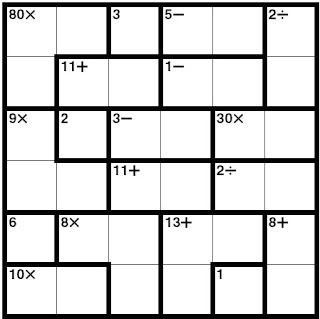Most of us are familiar with Sudoku, the number-placing game wherein the player should be able to place digits in what is usually a 9x9 matrix without the digits repeating vertically, horizontally, within a 3x3 sub-matrix, or sometimes, diagonally. I usually answer Sudoku puzzles in newspapers, Sudoku puzzle books, or those in my mother’s Reader’s Digest magazines, maybe to her dismay. Sometimes, I answer puzzles online.
Last year, wanting to answer a Sudoku puzzle, I borrowed my mother’s then latest copy of Reader’s Digest to read (and to answer the puzzle at the back). I found a 9x9 matrix, alright, but it was not a Sudoku puzzle. It was a KenKen puzzle.

KenKen, like Sudoku, is also a number-placing game, but with an arithmetic twist. In Sudoku, what is only required is that the digits do not repeat themselves either vertically, horizontally or within a sub-matrix of the main matrix. But in KenKen, there is an additional requirement: in a given sub-matrix, the digits should correspond to the mathematical operation indicated in the sub-matrix, such that if a “3+” is indicated in the sub-matrix, the mathematical operation is addition and the sum of the digits inside the sub-matrix should be 3. Within the main matrix, there should still be no repetition of digits vertically or horizontally or within the sub-matrix.
The puzzle can be intimidating at first, the Sudoku format itself being intimidating. What more if a little bit of math is added?
Thanks to Reader’s Digest, I discovered KenKen and I have been addicted to it ever since. Since Reader’s Digest magazines are issued only monthly and the game’s not that well-known locally to be placed in our newspapers, I answer online puzzles. Go to www.kenken.com and www.nytimes.com/ref/crosswords/kenken.html and try answering one.
photo from http://hourlypuzzle.wordpress.com/2009/07/10/the-ken-ken-puzzle-craze/
Kate Lomoljo
Entry No. 8

No comments:
Post a Comment